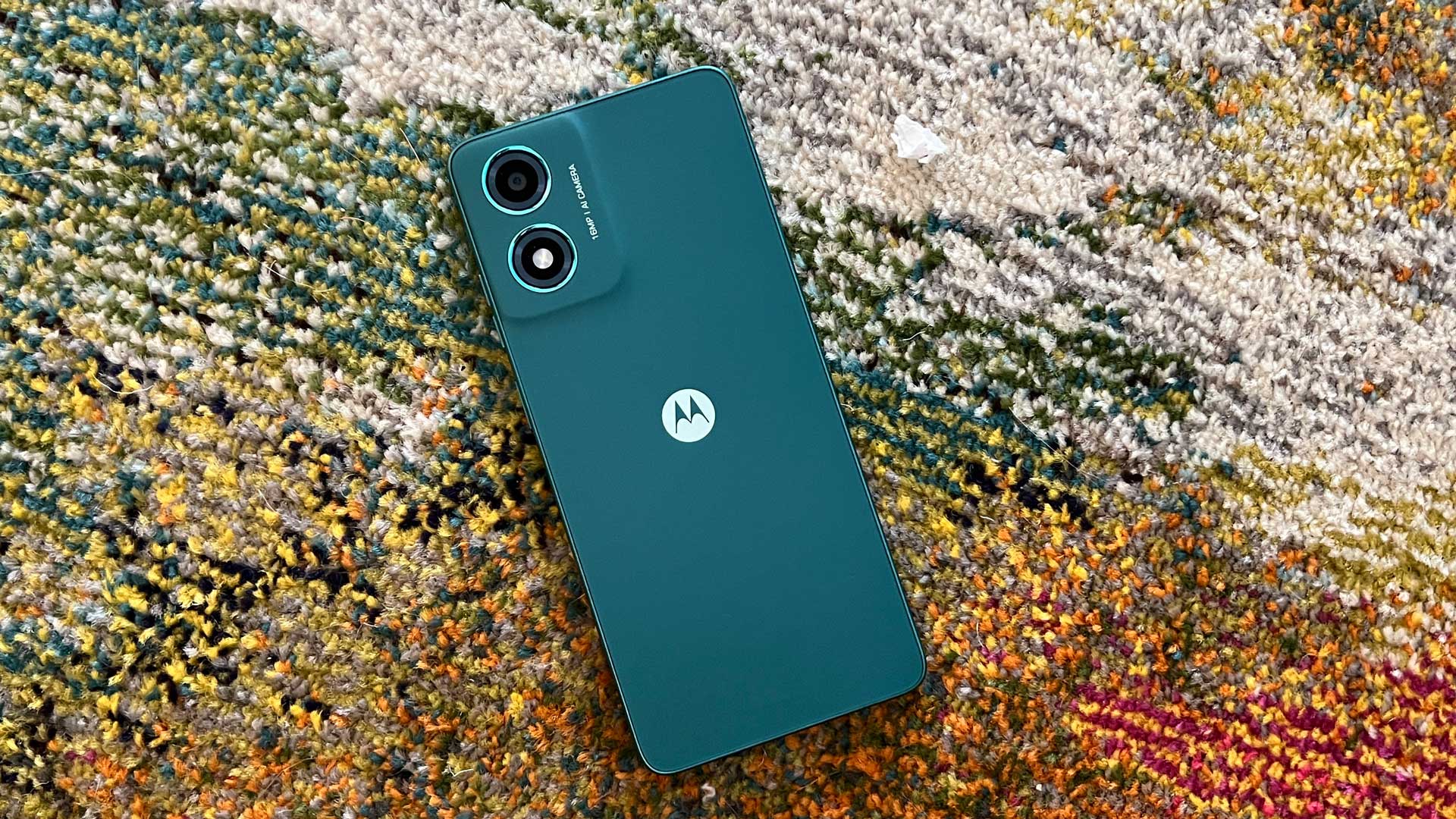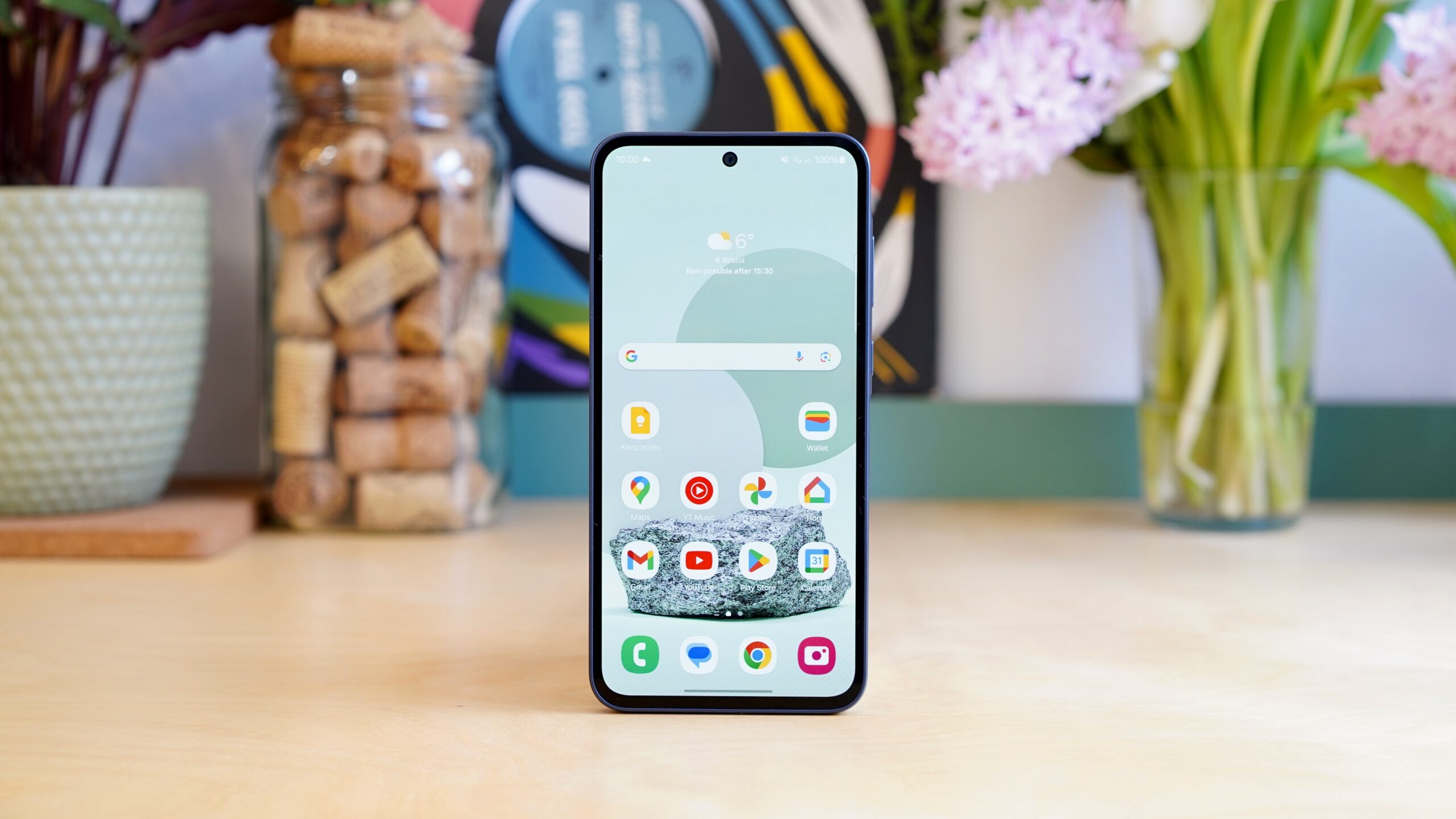Samsung Galaxy S23 FE Review
A great phone that has arrived a little too late to be tempting
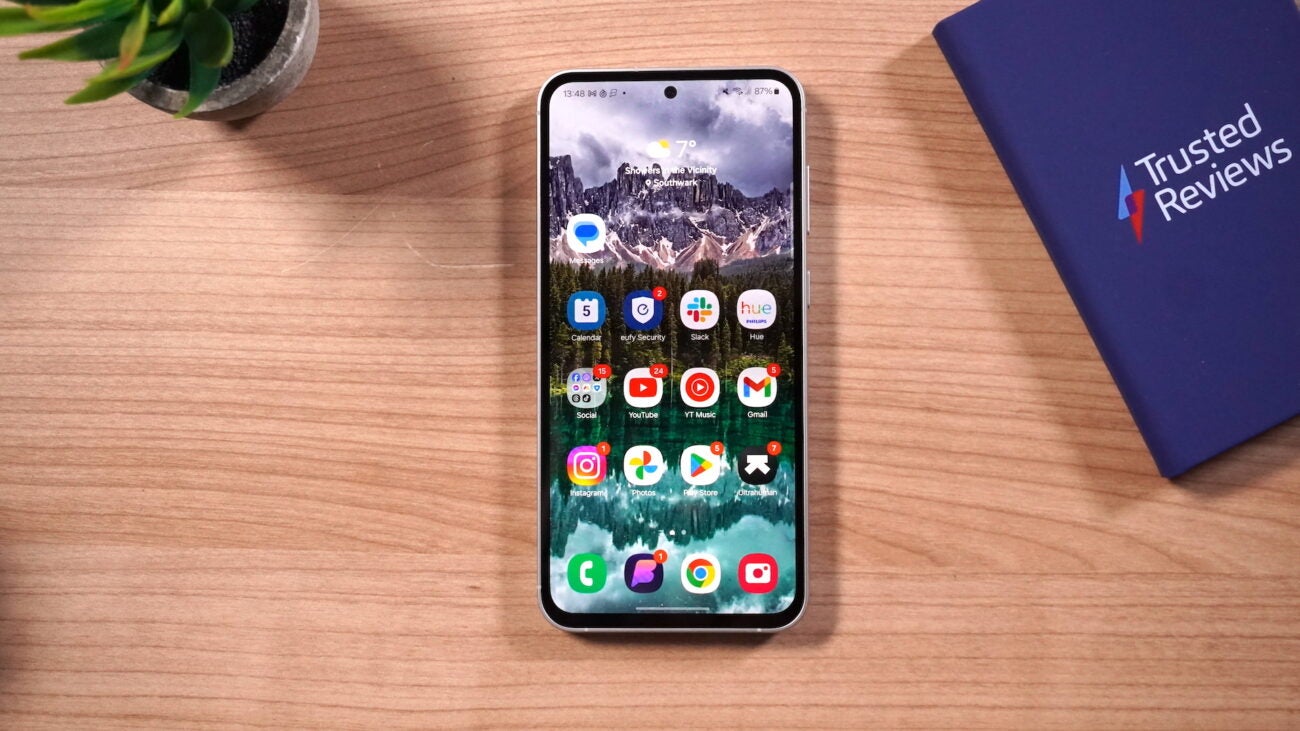
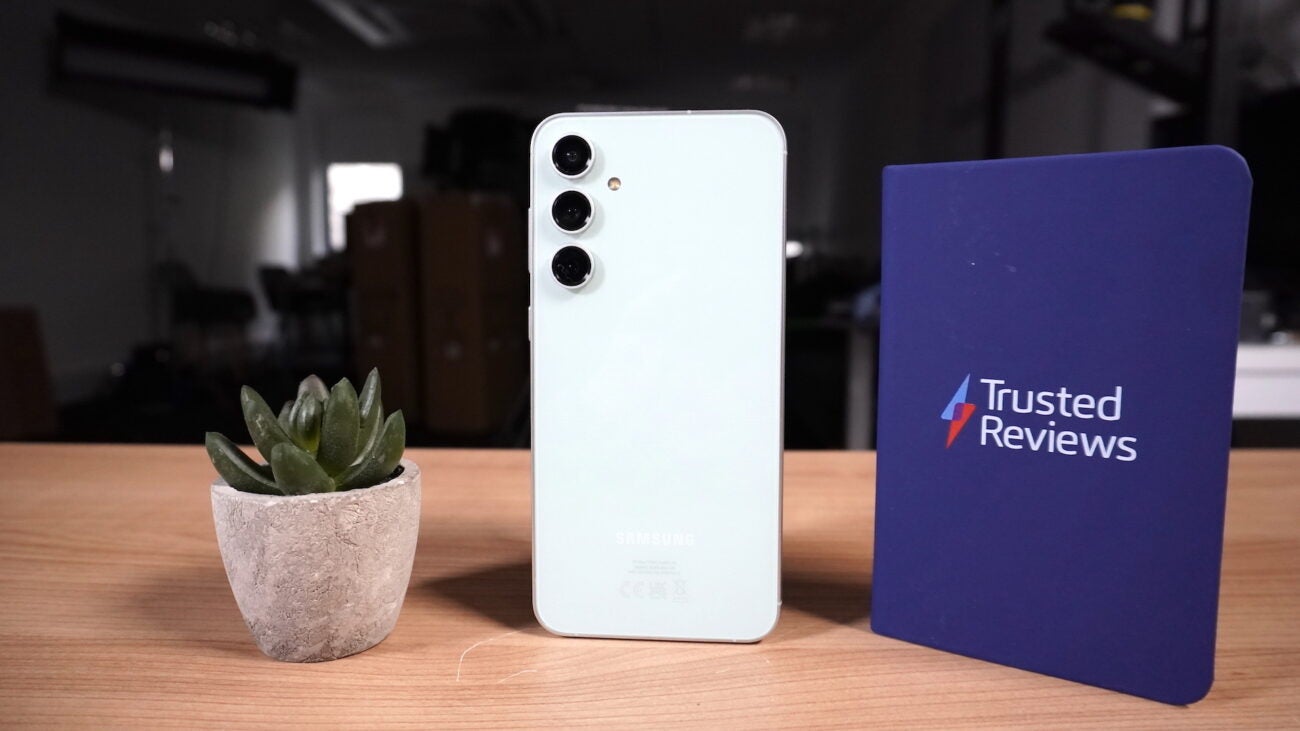
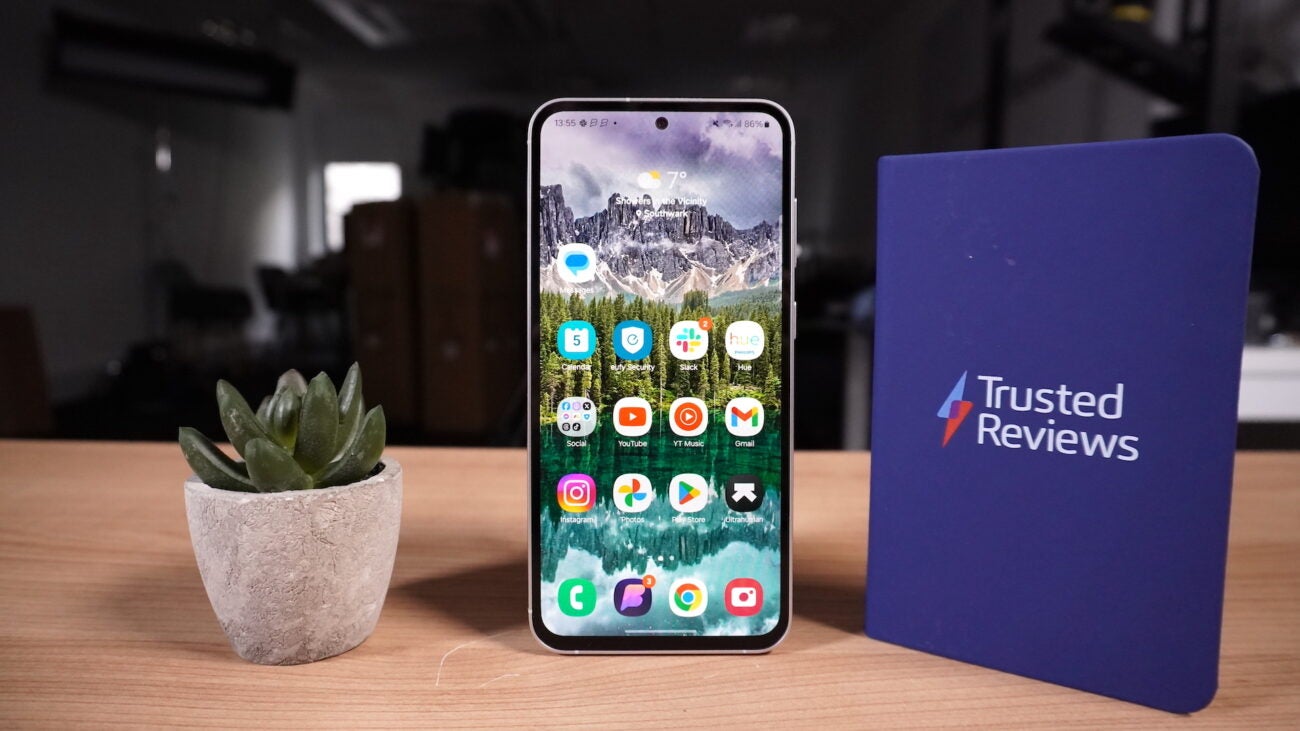
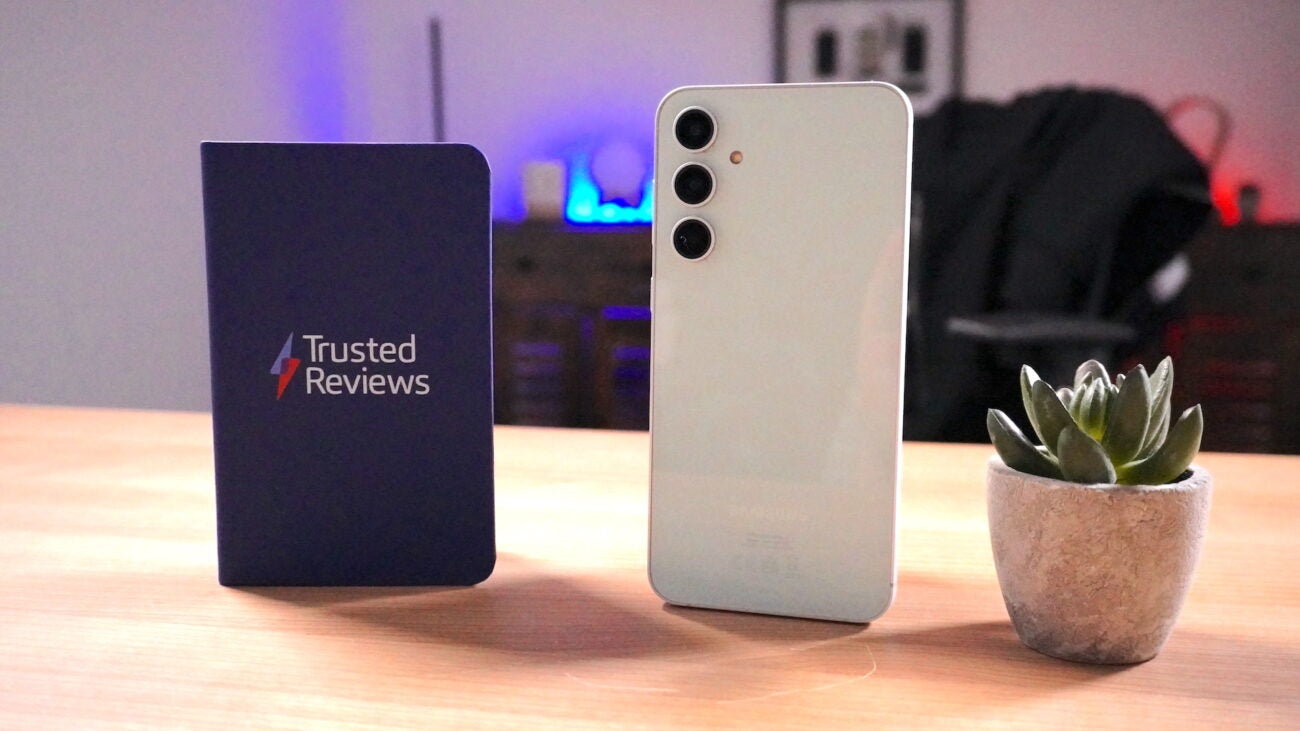
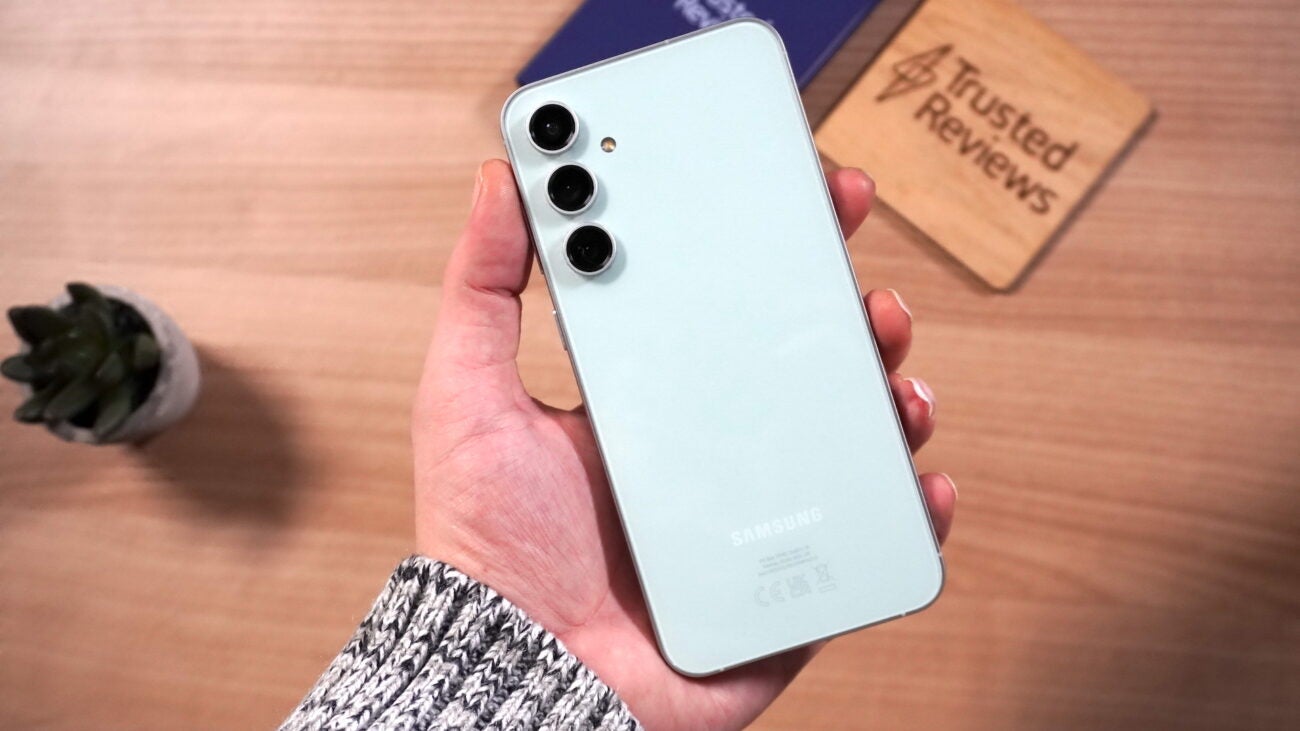
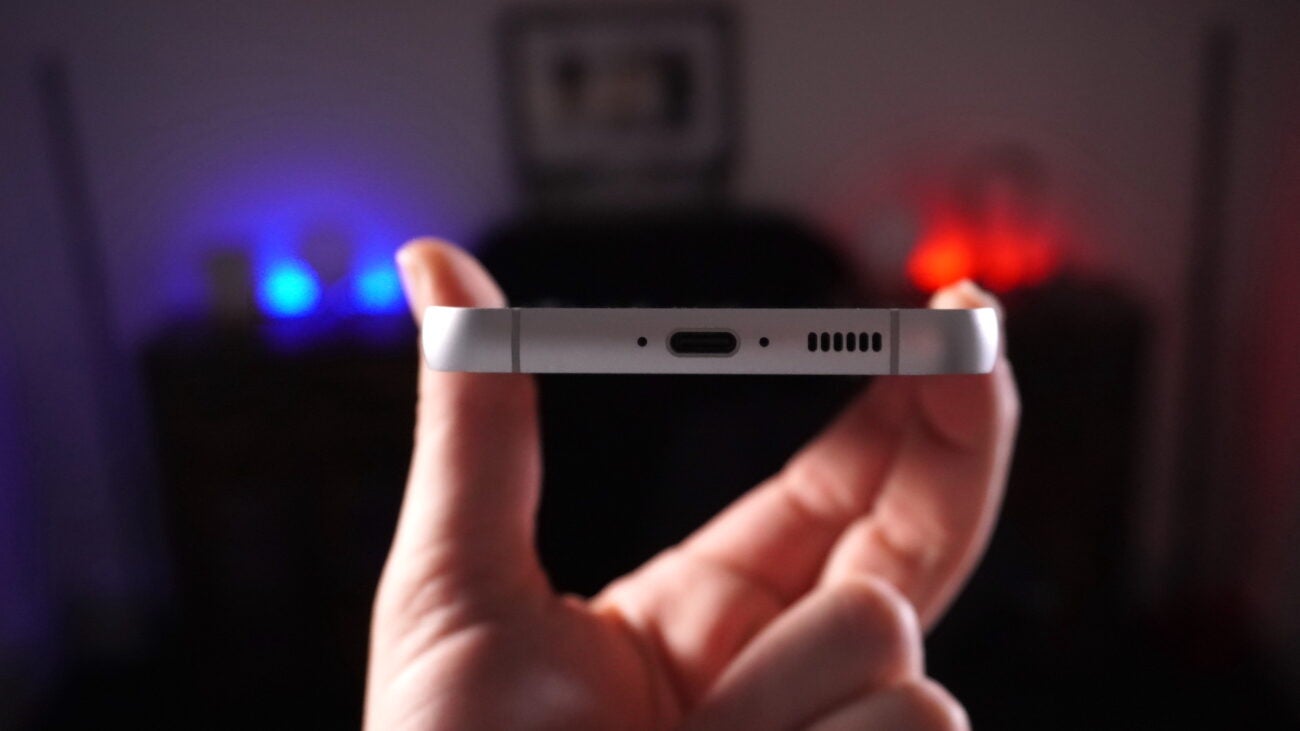
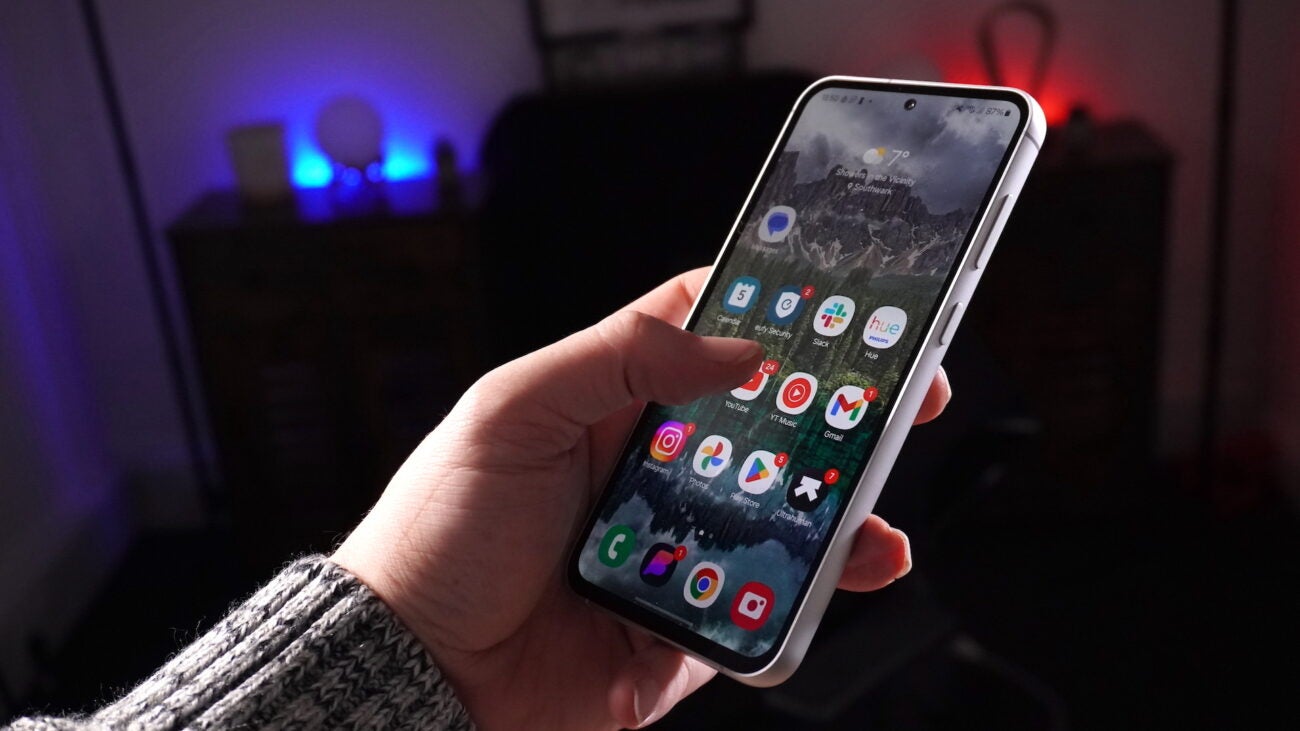
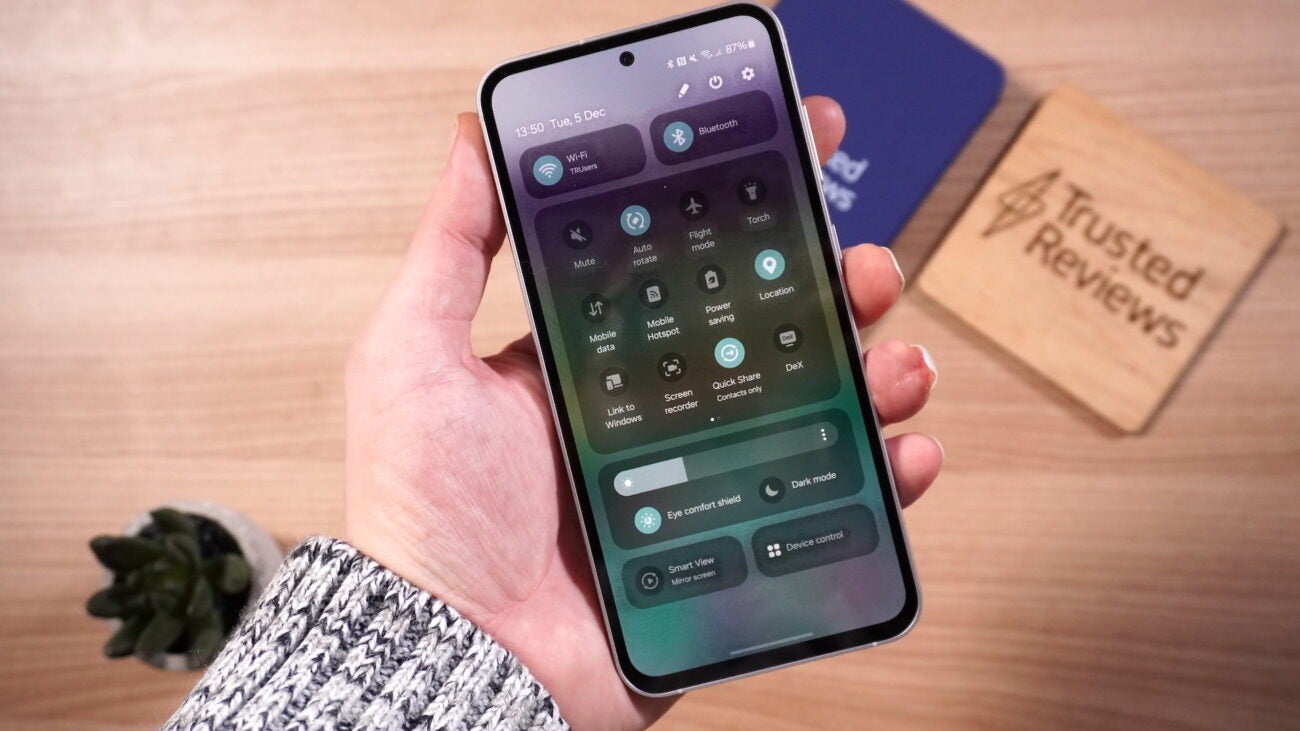
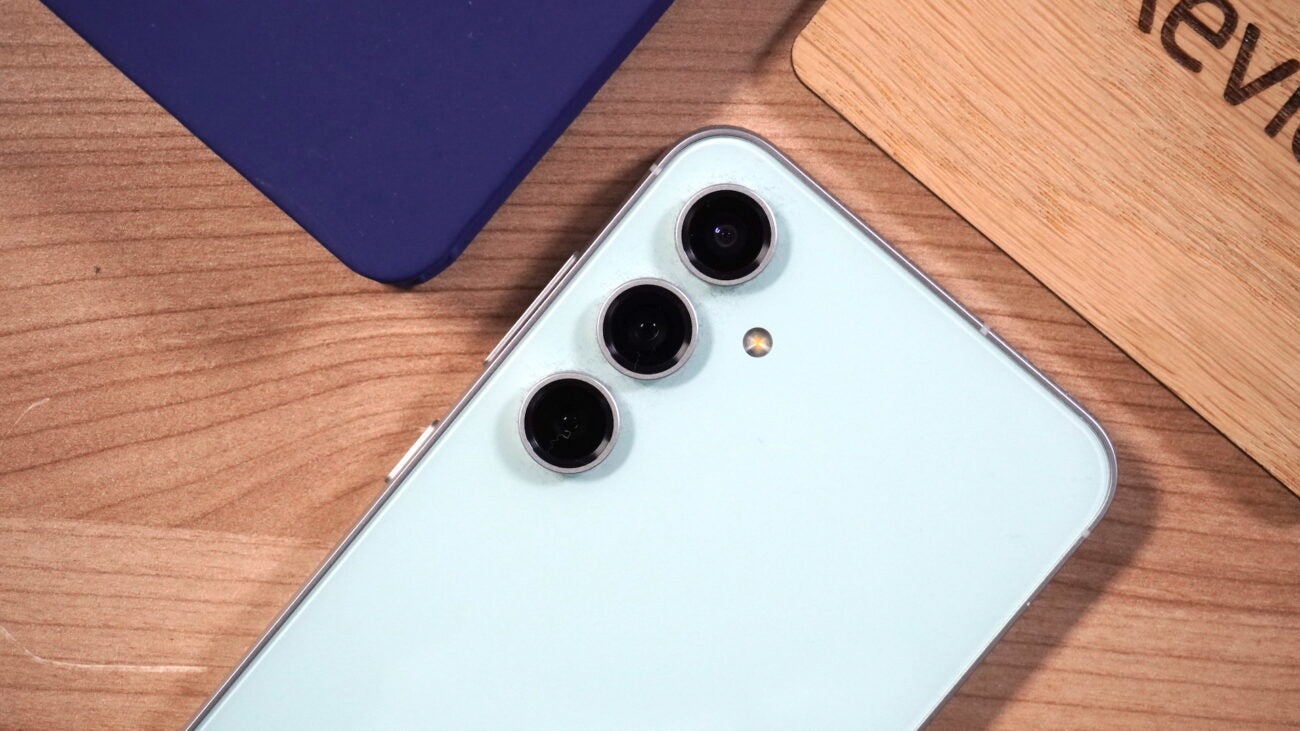

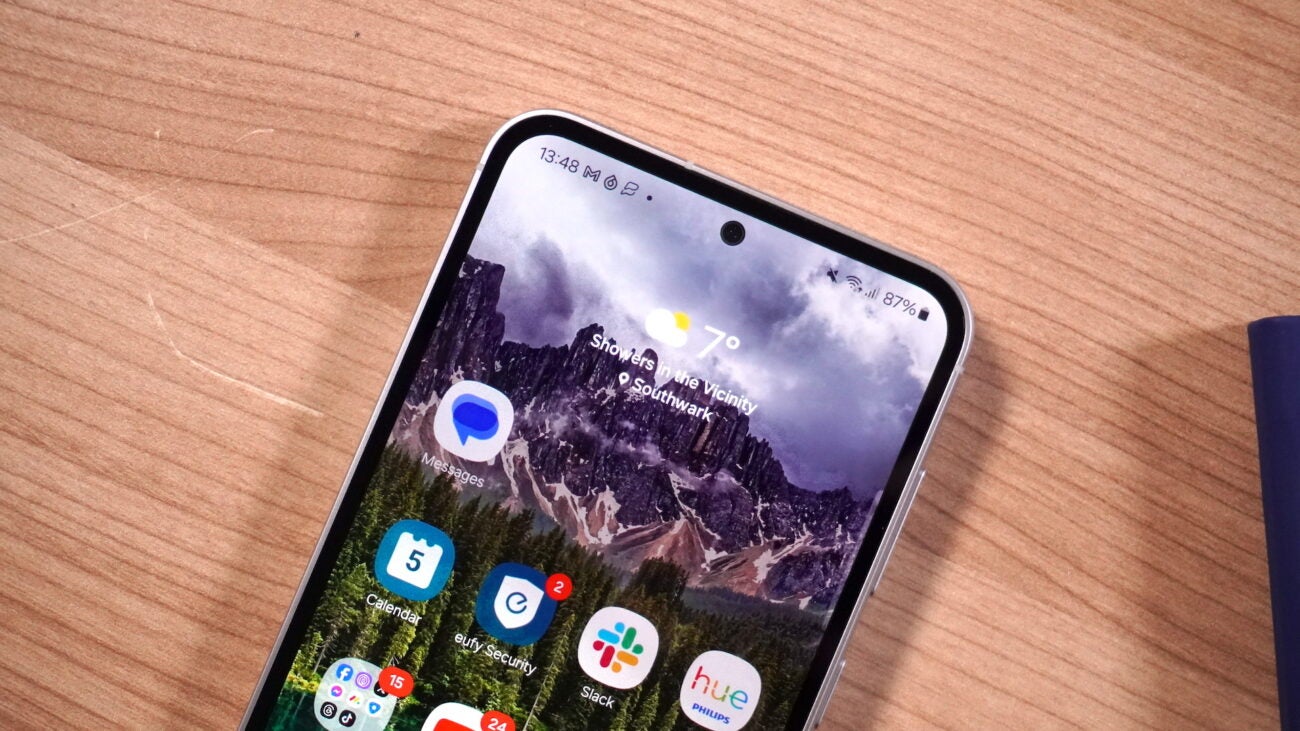
Verdict
By itself, the Samsung Galaxy S23 FE looks like a tempting option with flagship S23 DNA and the right compromises to fit its £599/$599 price tag – but with the regular Galaxy S23 already dipping beneath the FE’s RRP, it seems like it’s too little too late for Samsung’s premium mid-ranger.
Pros
- Very similar design to the Galaxy S23
- Great performance from the Exynos 2200
- All-day battery life
Cons
- The regular Galaxy S23 can be found cheaper
- Slow charging
- Fairly heavy for its size
Key Features
- Samsung Galaxy S23 DNAWith a similar design and many of the same features as the flagship S23, the S23 FE makes the right cuts to deliver a solid experience at a cheaper price.
- A dedicated telephoto lensThe 8MP 3x telephoto lens is a rarity in the mid-range market, allowing you to get even closer to the subject of your photos without a loss of detail.
- Solid all-day battery lifeThe Exynos 2200 chipset found in the UK/European variant of the S23 FE has no issues delivering comfortable all-day battery life.
Introduction
Samsung has revived the Fan Edition branding with its latest premium mid-ranger, the Samsung Galaxy S23 FE.
The idea is simple: deliver the flagship Samsung Galaxy S23 DNA with a few compromises to hit the cheaper price point. It makes sense considering the S23 FE’s £599/$599 price tag compared to the £849/$799 Galaxy S23.
And Samsung is largely successful in its aim, offering a solid experience with few notable compromises. However, the late 2023 timing of its release is far from ideal. In fact, it’s outright detrimental to the S23 FE.
That’s because the flagship Galaxy S23 has already dipped beneath the S23 FE’s RRP in many places, and it’ll drop again in the coming months with the expected release of the S24 range sometime in early 2024. What’s the point in opting for a phone with compromises when you can get the full-fat flagship for the same price, or even cheaper?
With that caveat out of the way, let’s delve a little deeper into the Samsung Galaxy S23 FE experience.
Design
- Near-identical to the Galaxy S23
- Heavier and thicker than the flagship
- IP68 dust and water resistance
It’s very difficult to tell the difference between the Samsung Galaxy S23 FE and the flagship Galaxy S23 range at a glance – and that’s the point. The goal of the S23 FE is to offer the flagship S23 experience at a cheaper price point.
That means you’ll get the same minimalistic design employed by the company’s 2023 flagship range, complete with rounded edges, a flat display, a simplistic trio of camera lenses on the rear and not much else.
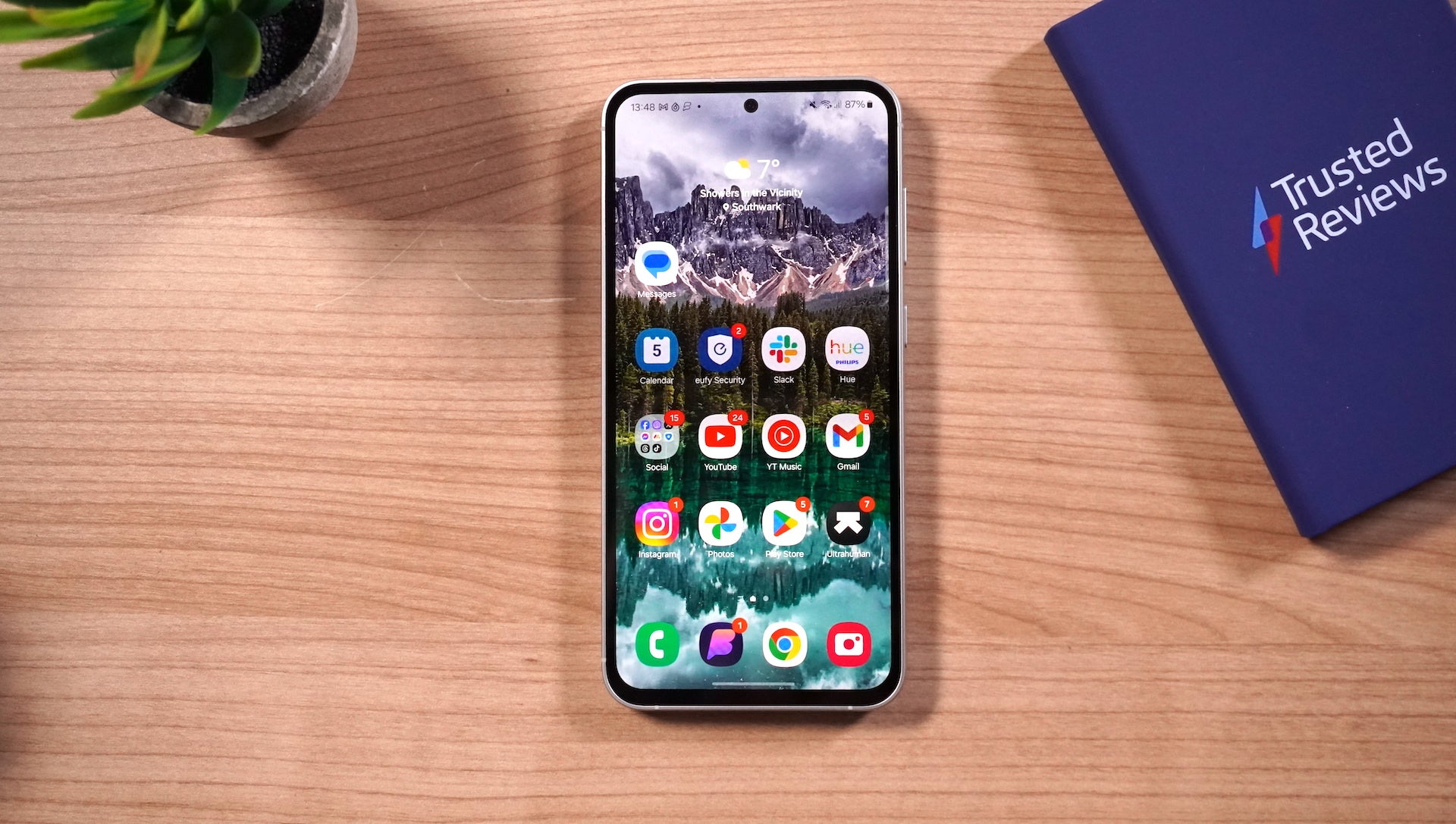
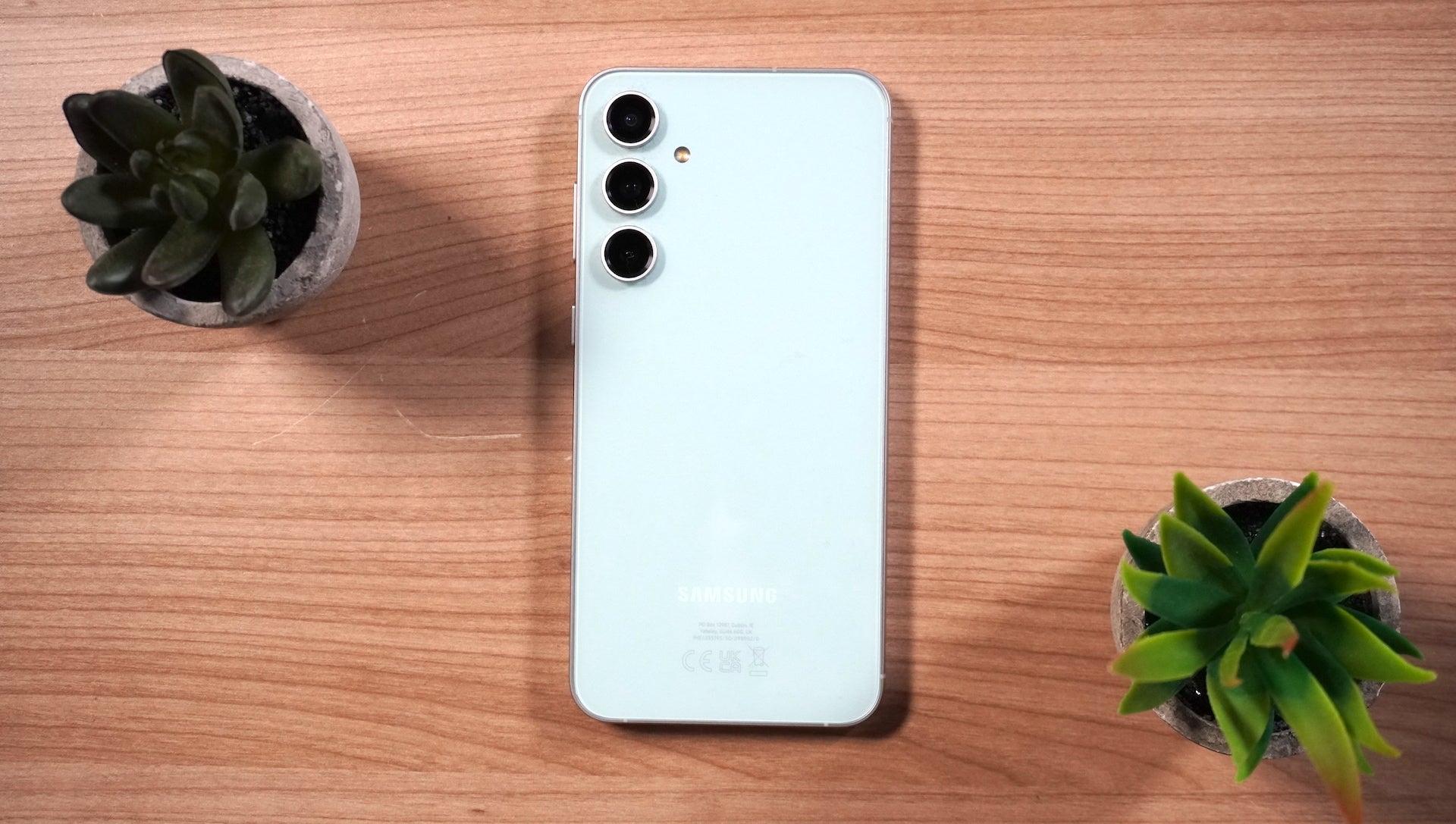
The S23 FE is also available in similarly muted pastel colours like Lime, Cream, Purple, Indigo, Tangerine and Graphite, with the Lime finish provided for review. It is a very light shade of green, so much so that it can sometimes look white in photos.
There are, of course, slight differences in the look of the two phones if you look close enough. Samsung had to get the price down, after all.
The S23 FE has slightly thicker bezels and a more prominent chin than the super-slim bezels of the S23 range, and the rear camera setup protrudes ever so slightly further from the chassis, but those will only be apparent if you’ve spent a lot of time using the flagship.
There are more apparent differences when picking the phone up, however. The S23 FE is noticeably taller and wider than the standard S23, down to a larger 6.4-inch panel than the 6.1-inch S23, but it’s also heftier at 209g. That’s not only because of the display – the similarly sized Google Pixel 7 weighs 197g.
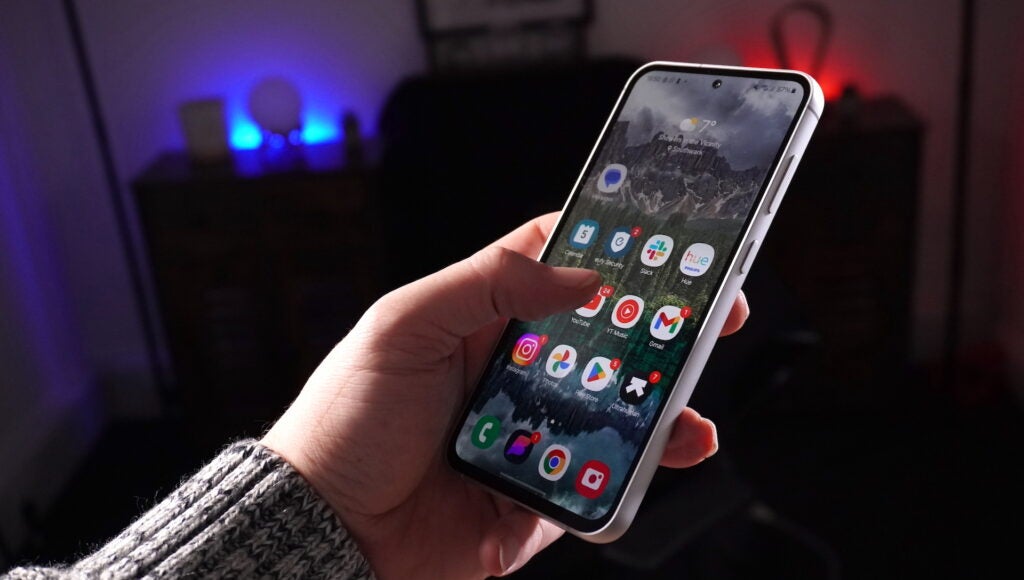
There are also differences in material; while you’ll get the same combination of aluminium and glass as the flagship, a step up from the plastic frame of the cheaper Galaxy A54 5G, it’s protected by Gorilla Glass 5 rather than the latest Victus 2.
That means it won’t survive a drop quite as well as the flagship, though with matching IP68 dust and water resistance, it could take a dunk in the water and survive unscathed.
That all said, I think the Galaxy S23 FE makes the right cuts to deliver the premium look of the flagship Galaxy S23 series while still offering key high-end benefits.
Samsung has made steps with its packaging with a largely recyclable cardboard box, although there is still the use of some single-use plastic that’ll go straight to landfill, so there’s still work to be done there.
Screen
- 6.4-inch display is larger than the regular S23
- AMOLED screen is vivid and bright
- Non-LTPO 120Hz refresh rate
The screen is one area where the Galaxy S23 FE diverges from the regular 6.1-inch Galaxy S23, with a 6.4-inch screen closer to the 6.6-inch S23 Plus. That means you’re getting marginally more screen real estate, which translates to a better experience when watching movies and gaming in particular – albeit to the trade-off of easy one-handed use.
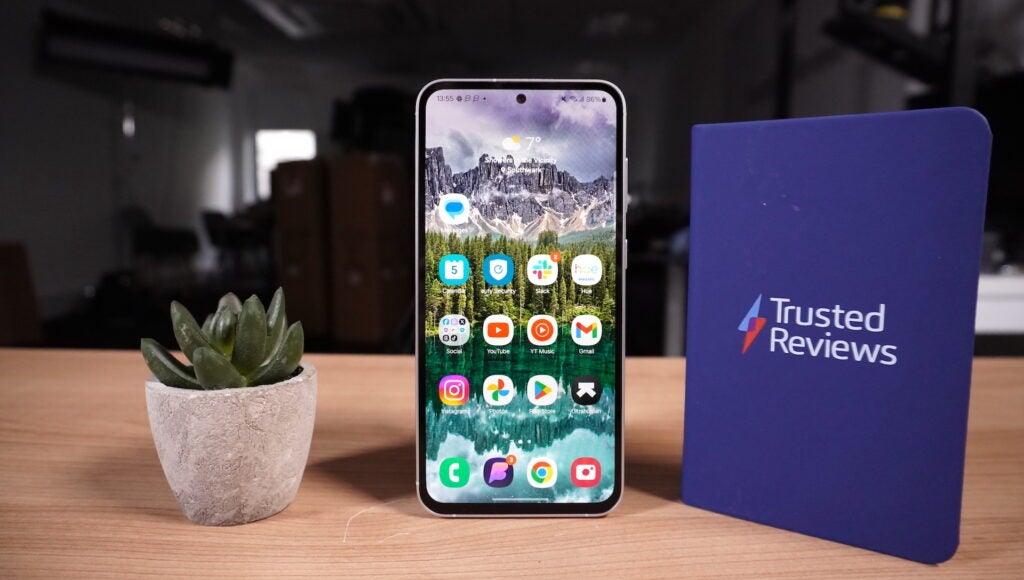
Size aside, the displays are fairly similar in terms of tech. Both the S23 and S23 FE share the same Dynamic AMOLED 2X with punchy, vivid colours and inky blacks that the tech is best known for.
They also sport a 120Hz refresh rate, although without the premium LTPO tech found on the flagship, the S23 FE can only switch between 120Hz and 60Hz. That won’t matter much in day-to-day use with generally buttery-smooth performance, but it does mean it’s not as battery-friendly as it could be.
They also share the same FHD+ (1080 x 2340) resolution, but the S23 FE’s larger screen means that it’s not quite as pixel-dense as the pocket-friendly flagship. The regular S23 can get marginally brighter too, at 1750nits compared to the S23 FE’s 1450nits.
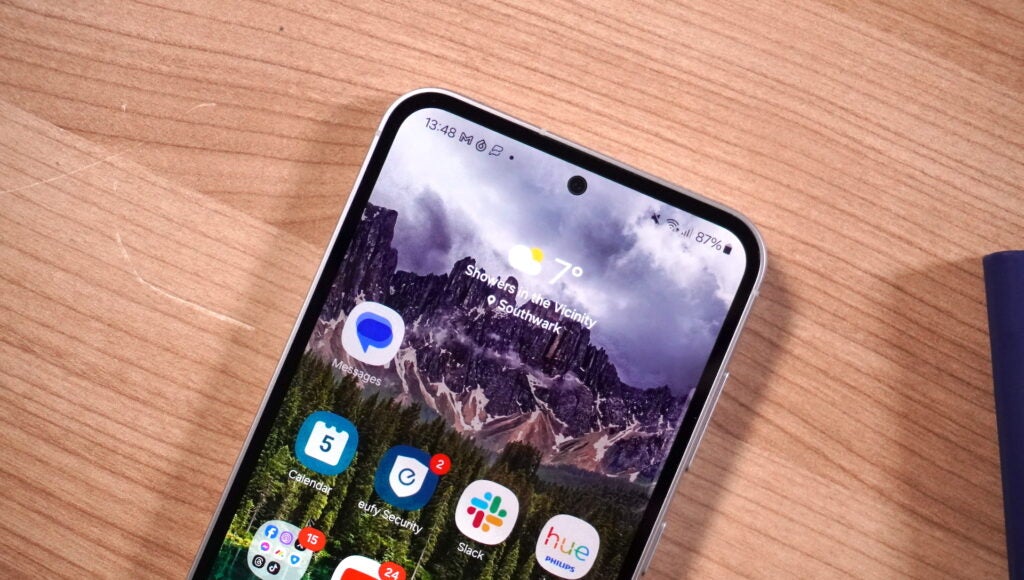
That said, unless you’ve spent a considerable amount of time with the flagship S23 range then it’s a perfectly commendable display. It’s bright enough for use outdoors, it’s smooth, and the AMOLED tech delivers vivid hues (sometimes a little too vivid, but that can be tweaked in the Settings menu), ideal for watching video content and gaming.
It might not do much to truly stand out from the upper mid-range competition, but it does its job well enough.
Cameras
- Same main and ultrawide lenses as the S23
- 8MP telephoto is a rarity at the price point
- Great performance from the primary lens
The Galaxy S23 FE comes pretty close to what the flagship Galaxy S23 offers when it comes to camera hardware, with an identical 50MP primary lens and 12MP ultrawide. However, the S23 FE’s 8MP telephoto is slightly beneath the 10MP alternative on the flagship.
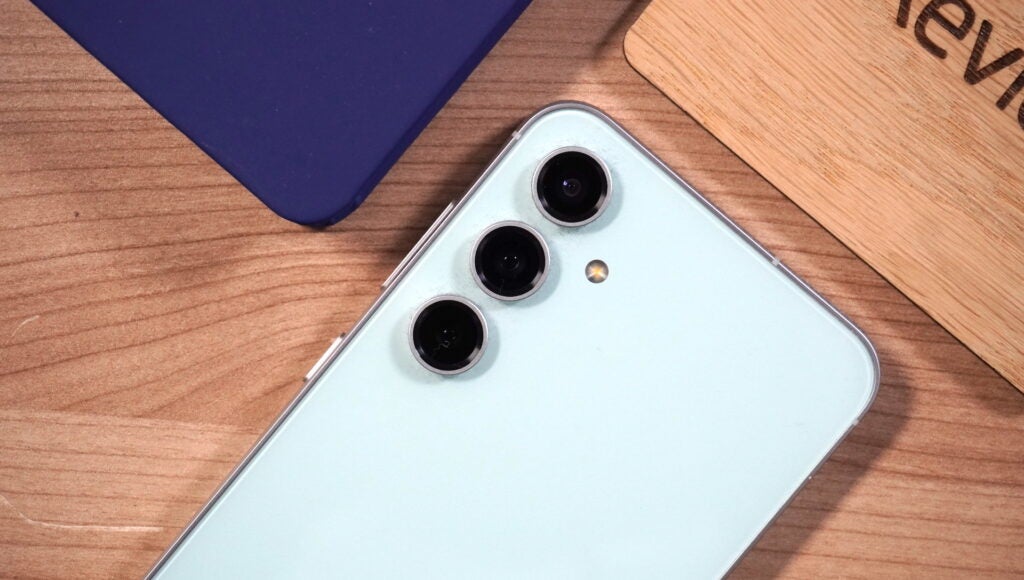
That said, the 50MP primary lens delivers fairly similar results to the flagship in the majority of scenarios, both well-lit and low-light. There’s the signature oversaturation favoured by Samsung across its smartphone range, and while that means images aren’t quite true to life, they look especially vivid on the phone’s AMOLED panel and look great on social media.





Images taken on a nice day were packed full of detail with decent dynamic range, though the phone can occasionally get the exposure a little wrong. That can sometimes lead to a washed-out look in images, but that only happens in challenging scenarios with the sun (or another extremely bright source of light) in the shot.
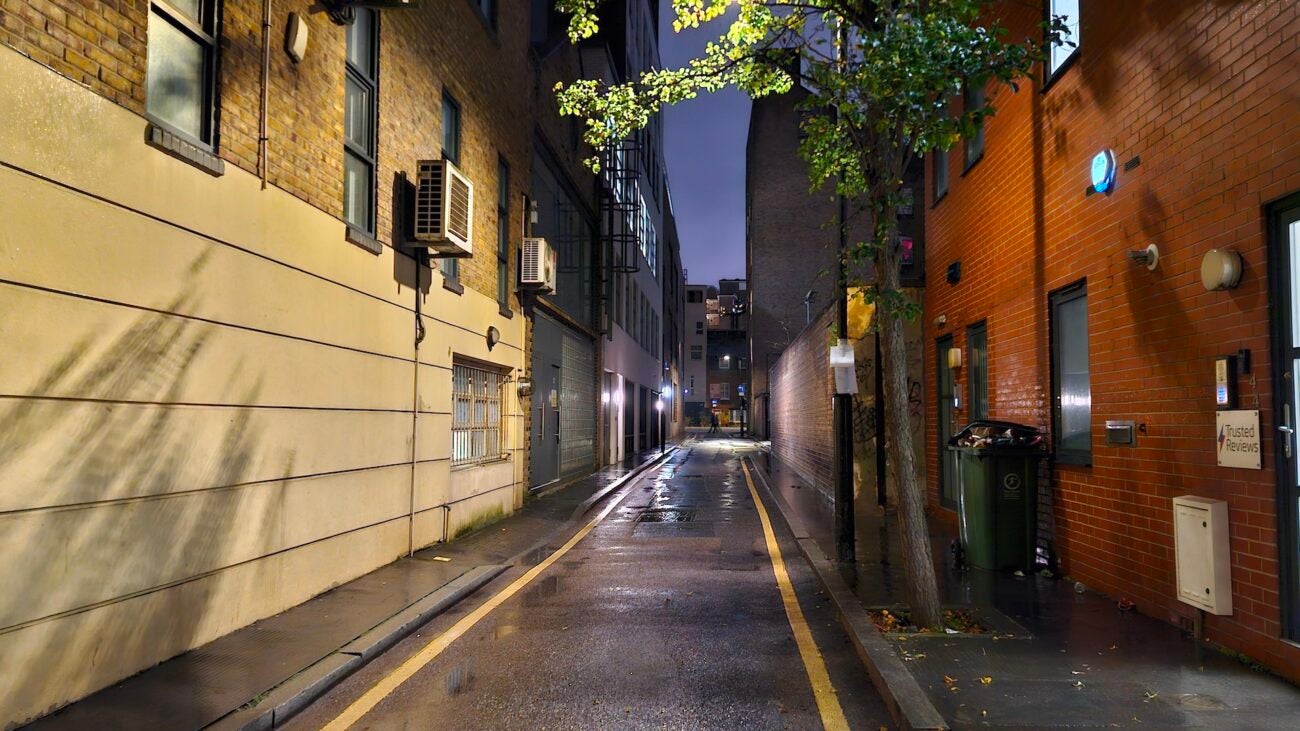
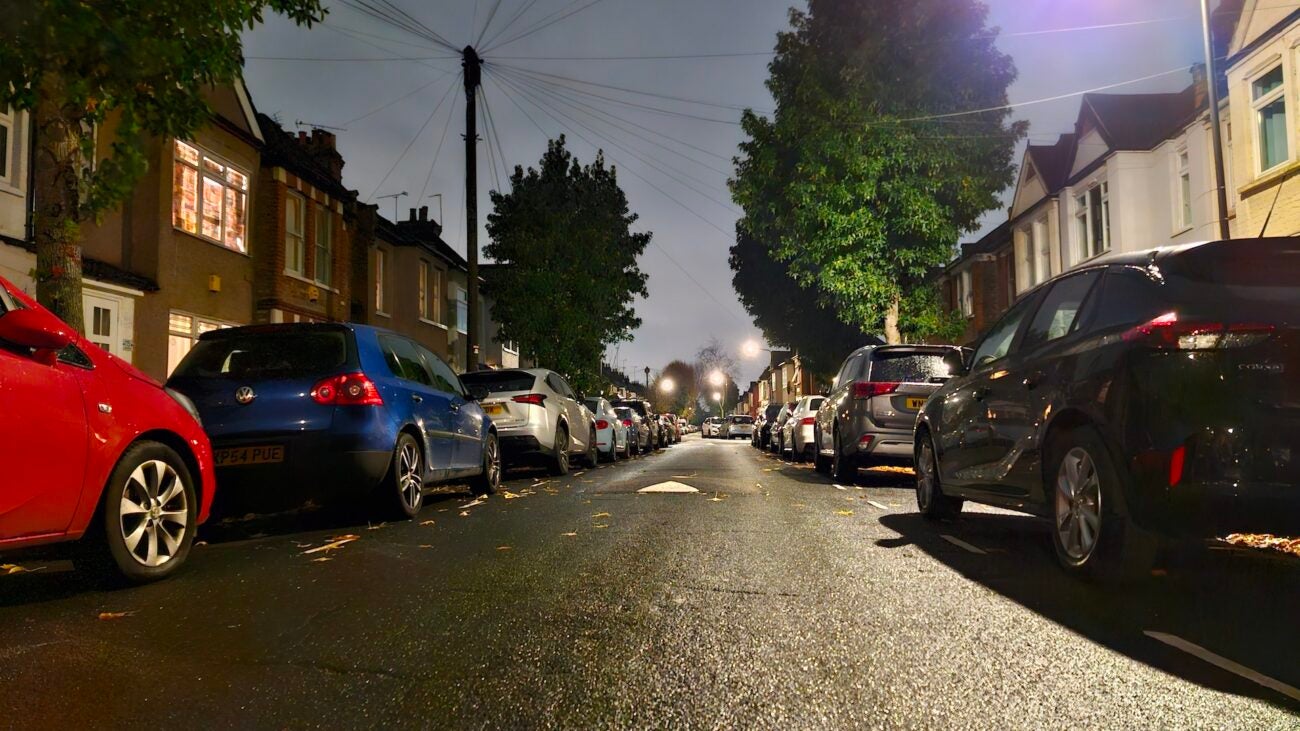
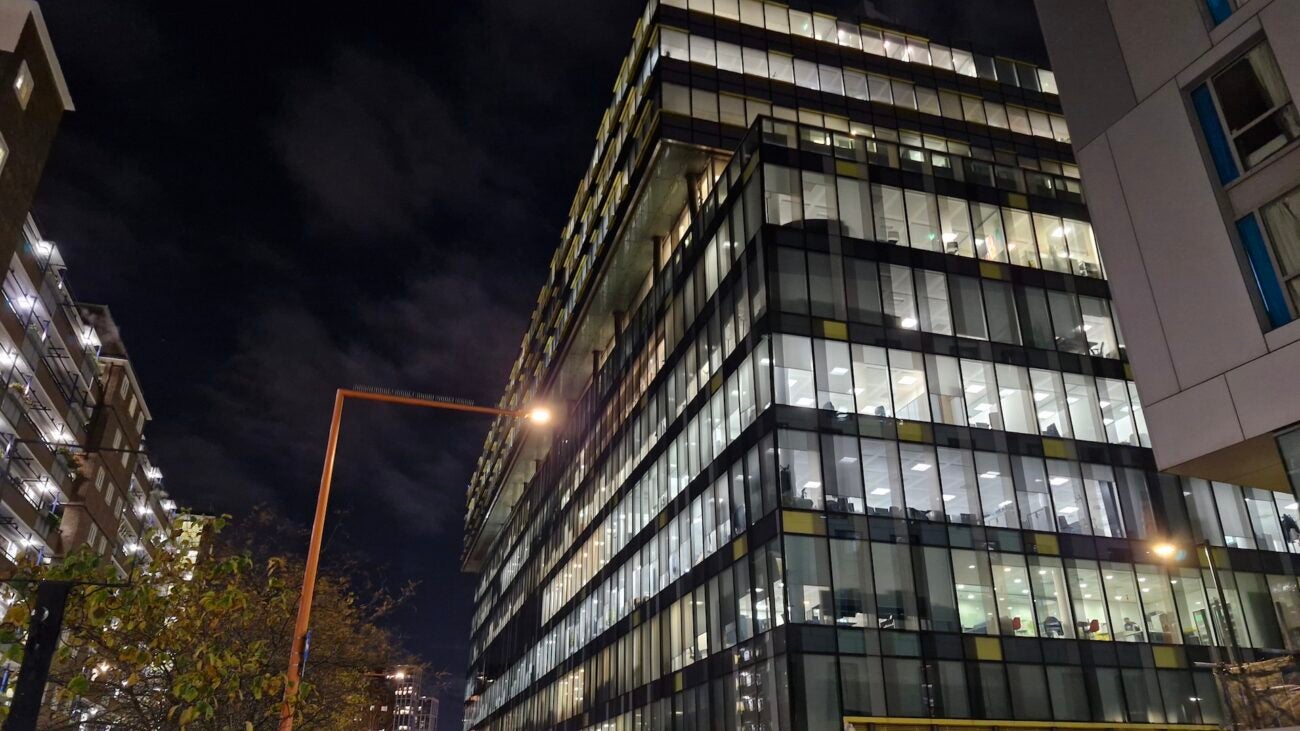

Low-light performance was just as performant thanks to a relatively wide f/1.8 aperture and OIS support, allowing the phone to slurp in as much light as possible. It won’t unnaturally lighten dark environments like some high-end alternatives, but I prefer the more natural evening look in the photos I took on my travels around London.
The telephoto lens, even with a downgraded megapixel count compared to the regular S23, can still deliver great 3x zoomed shots. It’s best suited to portrait photography with its narrow FOV, but it also helps close the distance between you and a far-off subject without relying on digital zoom.



The only complaint I have about the telephoto is that the colour tuning is slightly off compared to the primary and ultrawide lenses. This can be seen in the below images – pay particular attention to the maroon paint on the bridge.


However, the fact that there is a telephoto lens rather than the macro or depth sensors often seen in three-camera setups at this price point is a massive win for the S23 FE that allows it to stand out from the mid-range crowd.
Rounding out the trio of lenses is the same 12MP ultrawide that you’ll find on the regular S23, with similar performance on offer.
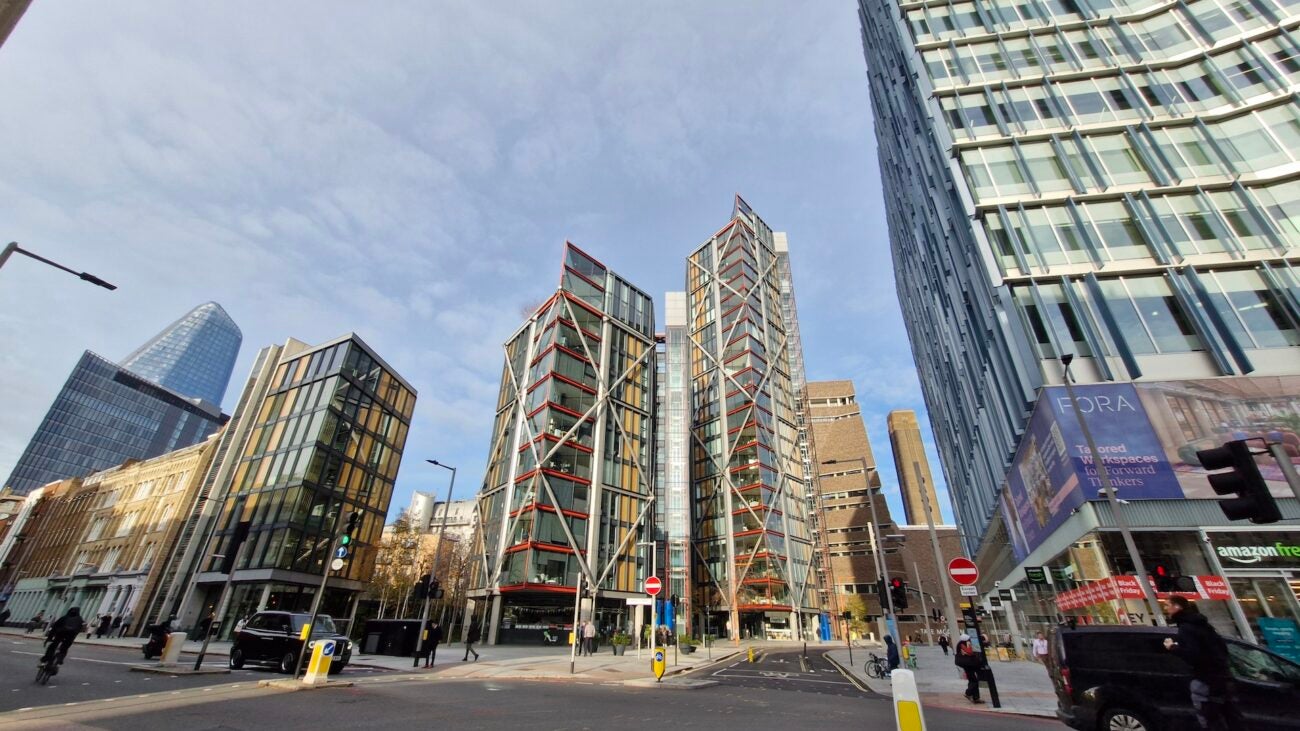

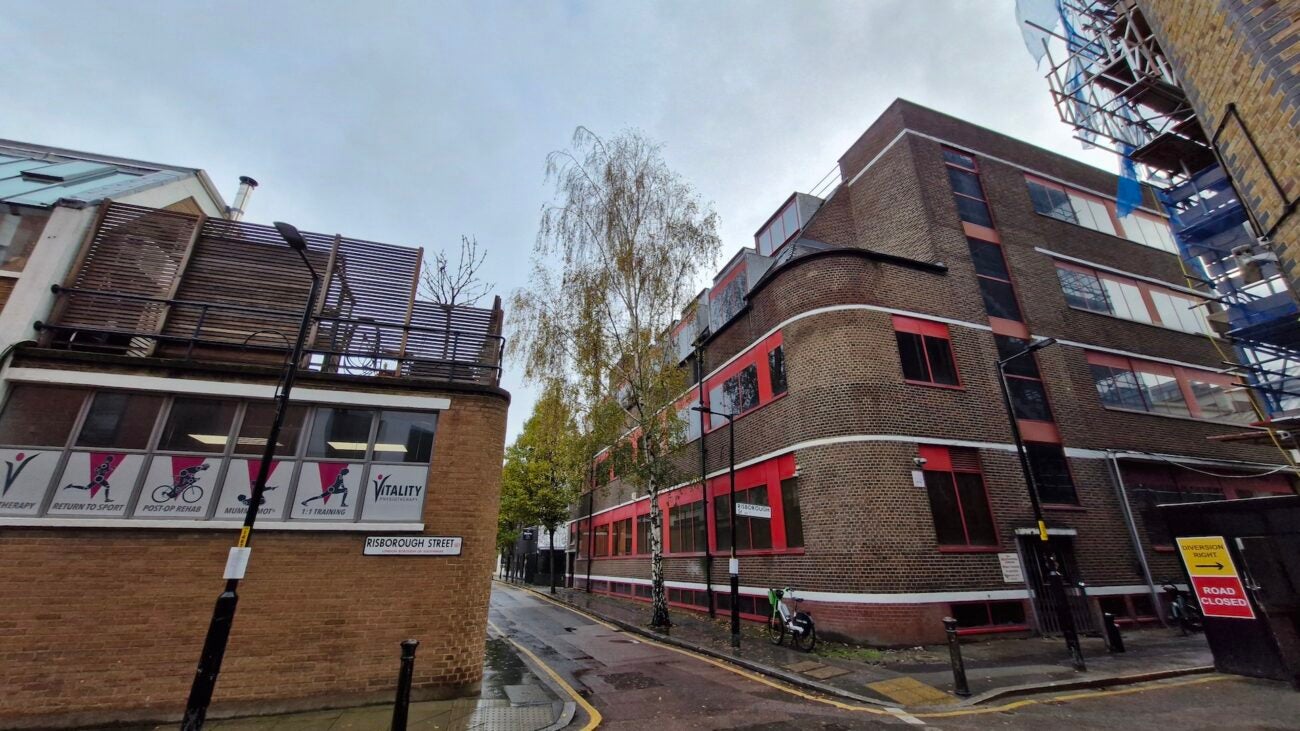
That means you’ll get generally vibrant shots with a 120-degree wide-angle ideal for scenic vistas and group shots. It suffers from slight fish-eye distortion around the edges of images taken, but how noticeable this is depends on the composition of your shots. You also lose some of the detail compared to the main lens, with small details like brickwork looking smoother than it should in places.
Flip the phone over, and you’ll find a 10MP selfie camera that’s fine for the occasional selfie and more than adequate for video calls, though it is more washed-out than the rear lenses.
Video is also covered at up to 8K@24fps available from the rear lenses, though I’d recommend the more stabilised 4K@60fps for everyday use. You don’t get the HDR10+ capture and stereo sound recording of the flagship S23, but those are rather niche features anyway.
Performance
- Snapdragon/Exynos split is back
- Early 2022 flagship chipset delivers decent performance
- Outpaced by similarly priced alternatives
The performance of the Galaxy S23 FE will depend on where you are in the world. Those in the US will find the Snapdragon 8 Gen 1, while those in most other regions including the UK and Europe get Samsung’s own Exynos 2200 chipset. These are both flagship-level chipsets, albeit ones from early 2022.
But while I’m usually frustrated with the Snapdragon/Exynos split employed by Samsung, it actually works out in favour of the Europeans for a change.
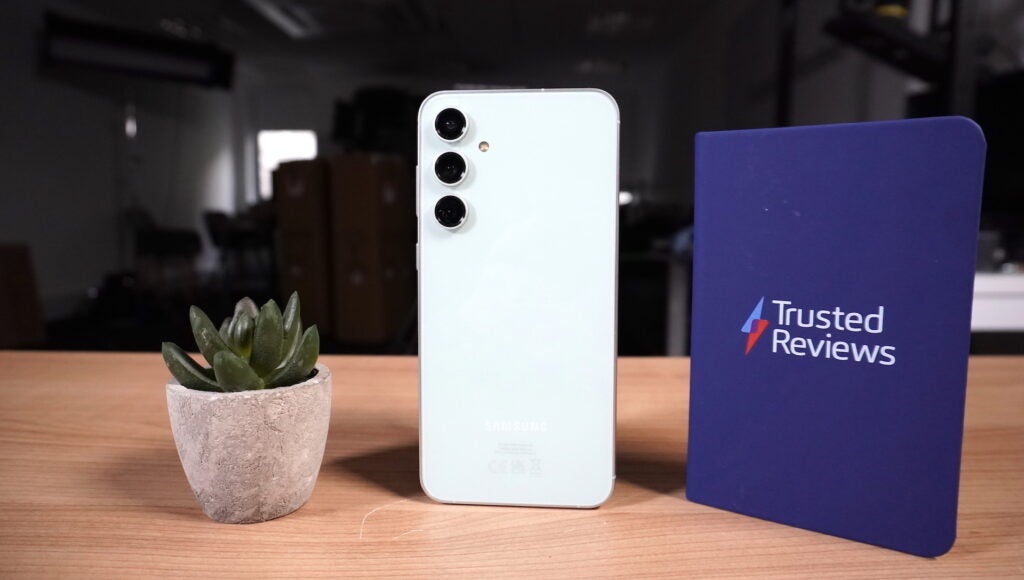
That’s because the Snapdragon 8 Gen 1 had a bit of a reputation for quickly overheating, which harmed overall performance and game performance in particular. It came to a head with the Xperia 1 IV, which was sometimes near-unusable.
I can’t be sure whether Samsung has tweaked its internal design to accommodate the 8 Gen 1’s hot temps, but I can certainly say that the Exynos 2200 variant does not suffer from the same issues. Sure, I still saw a bit of a dip in the Wildlife Extreme Stress test, down to 66.8%, but that’s not even close to the worst scores we’ve seen at Trusted. In fact, it’s almost identical to the Pixel 8 Pro’s performance.
More generally, the Exynos 2200 can handle just about anything thrown its way with buttery smooth ease, be it loading apps, scrolling through media-heavy timelines or playing games like Diablo Immortal at a stable 60fps. The only time I encountered lag was when scrolling through the Google News app, though I feel that’s more of an app optimisation issue than a problem with the chipset.
It also means you’re getting close to flagship-level power at a relatively cheap price, although the Exynos 2200 is bested by the Snapdragon 8 Plus Gen 1 of the Nothing Phone (2), a phone that costs £20 less in the UK. That said, you’re unlikely to notice much difference in everyday use.
The bigger crux is the S23 itself, which as noted, can often be found at a discount – sometimes even cheaper than the S23 FE’s £599/$599 price tag. With its overclocked Snapdragon 8 Gen 2 for Galaxy chipset, it can easily outperform the S23 FE, even if the two share the same 8GB of RAM.
The S23 FE offers 128GB or 256GB of storage, which should be ample for most users, but true power users might need to opt for the regular S23 and its 512GB option, especially considering the phone doesn’t have a microSD card slot.
Elsewhere, users can look forward to premium connectivity options including 5G, Wi-Fi 6E, Bluetooth 5.3 and eSIM support in addition to a physical SIM card tray.
Software
- Android 14 and OneUI 6 now available
- Refreshed UI is a pleasant surprise
- Samsung-branded alternative apps still present
The Samsung Galaxy S23 FE came with Android 13 and OneUI 5.2 when it initially launched in October in the US, though it has since jumped to Android 14 and Samsung’s updated OneUI 6.
That means UK users will get it out of the box, and it also makes it one of few current mid-rangers already on the latest software, but it’s not as exciting as it sounds. The yearly Android OS upgrades over the past few years haven’t been as exciting as equivalent iOS upgrades, focusing more on background features than shiny new functionality.
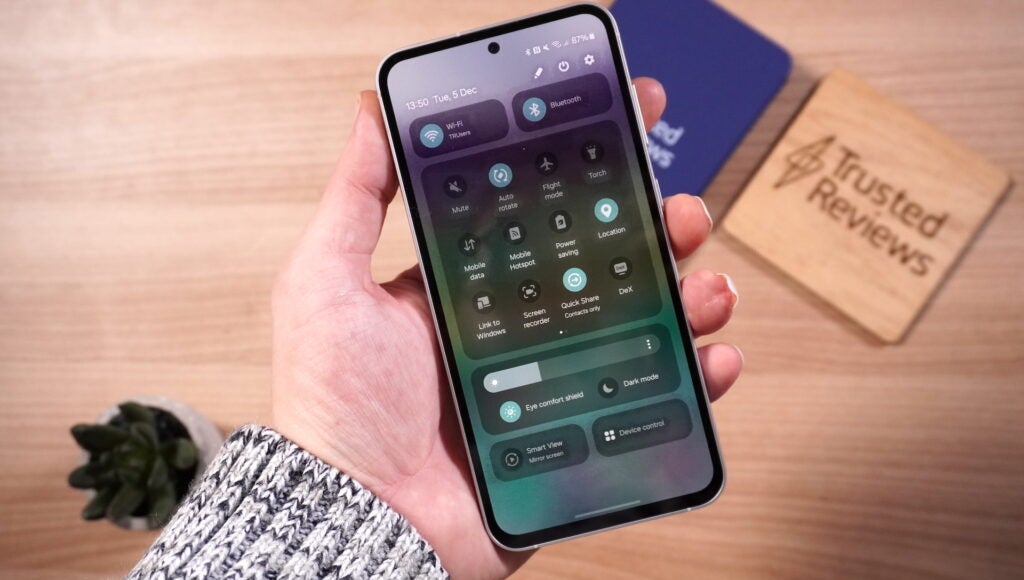
That said, OneUI 6.0 does at least give certain elements of Samsung’s interface a much-needed facelift. That means elements like quick controls and notifications look a little nicer on the newer software, but aside from small visual tweaks, it functions in essentially the same way that OneUI 5.2 did with Android 13.
That means you’re getting the same signature Samsung experience, for better or worse. It’s great if you’re already familiar with the OS as it offers little learning curve, but it also means the weak points – like Samsung’s endless army of clone Google apps – are still present and accounted for.
That said, the Galaxy S23 FE will get the same four OS upgrades and five years of security patches as the regular S23, so there’s still a possibility that your Galaxy S23 FE could look and feel different in the coming years. It’s also great for long-term use, seeing users through even the lengthiest phone contracts with yearly OS upgrades.
Battery life
- 4500mAh battery
- Can easily last all day
- Relatively slow 25W charging
While I might not traditionally be a massive fan of the Exynos/Snapdragon chipset split, it does work out well for us Europeans, as the Snapdragon 8 Gen 1 had a bit of a reputation in early 2022 for relatively poor battery efficiency. Samsung’s Exynos 2200 chipset, on the other hand, doesn’t have the same obvious power efficiency issues.
That’s especially true of the Galaxy S23 FE, with its combination of the 2200 and a fairly decently sized 4500mAh battery. It’s not the 5000mAh cell found in a lot of alternatives, but it’s a negligible difference in terms of real-world use – and crucially, it’s much larger than the regular S23’s 3900mAh cell.
That said, I’ve not found myself wanting when it comes to overall battery life with the Galaxy S23 FE. The phone is more than capable of a full day’s usage, which in my case is a combination of scrolling through TikTok and Instagram, making a few calls, checking emails, taking the occasional photo and, of course, plenty of music listening. Over an 18-hour day, I’d usually get to bed with around 20-30% left in the tank.
That means it’s not quite a two-day device, usually powering down by around lunchtime the following day, but considering most of us still charge our phones overnight, I wouldn’t say that’s much of an issue.
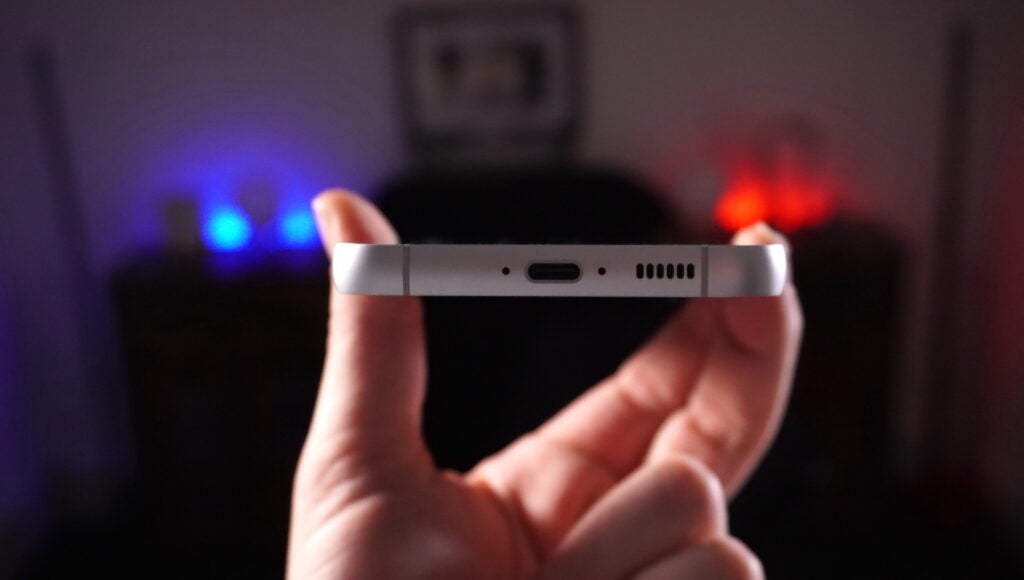
Charge speeds aren’t quite up there with the best, however, capping out at a rather middling 25W or 15W if charging wirelessly. That translates to a bit of a slow charging experience compared to the 68W of the similarly priced Motorola Edge 40, and without a charging brick in the box, you’ll have to source a compatible charger yourself.
Using a third-party Ugreen charger, I found that it’d take 44 minutes to reach the 50% mark, while a full charge took over double the time at 97 minutes. For context, the regular S23 and S23 Plus hit the 100% mark in 80 minutes, while the Edge 40 regained a full charge in 44 minutes, so it’s not great, even at its cheaper price point.
Latest deals
Should you buy it?
You want the regular S23 experience on a budget
The idea of the S23 FE is to deliver the S23 experience at a cheaper price point – an aim that’s largely achieved.
You want the best performance possible
With better performance from similarly priced alternatives like the Nothing Phone (2), and with the S23 itself dropping beneath its RRP, you’ll find better performance elsewhere.
Final Thoughts
The Samsung Galaxy S23 FE is a solid phone when looked at singularly; it’s competitively priced with great performance, it boasts a trio of cameras including a telephoto that’s not usually found in the mid-range market, you get long-term software support and all-day battery life.
However, the S23 FE isn’t alone in the smartphone market, and that’s where things start to get complicated. There are similarly priced phones that offer better performance, like the Nothing Phone (2), and there are others like the Motorola Edge 40 that offer a slimmer build and faster charging, making it hard for the S23 FE to stand out aside from that aforementioned telephoto camera.
But, the final nail in the coffin has to be its cousin, the Samsung Galaxy S23. The FE is designed as a budget alternative to the flagship and, as such, misses out on some key high-end tech.
The issue is that the S23 FE comes almost a year after the S23, in the UK at least, and that means the S23 can be found at quite a discount. In fact, we’ve already seen the flagship dip beneath the £599/$599 RRP of the S23 FE, and it’ll likely drop again in the coming months with the expected release of the S24 series sometime in early 2024. That begs the question: what is the point of the S23 FE?
If the Galaxy S23 FE had launched alongside the Galaxy S23 earlier this year, it would’ve been a much more exciting proposition. However, in late 2023, it just doesn’t do enough to justify its existence, even with a relatively solid experience on offer.
How we test
We test every mobile phone we review thoroughly. We use industry-standard tests to compare features properly and we use the phone as our main device over the review period. We’ll always tell you what we find and we never, ever, accept money to review a product.
Find out more about how we test in our ethics policy.
Used as a main phone for a week
Thorough camera testing in a variety of conditions
Tested and benchmarked using respected industry tests and real-world data
FAQs
No, you’ll have to source your own 25W charger separately.
Yes. In fact, it matches the flagship S23’s IP68 dust and water resistance.

